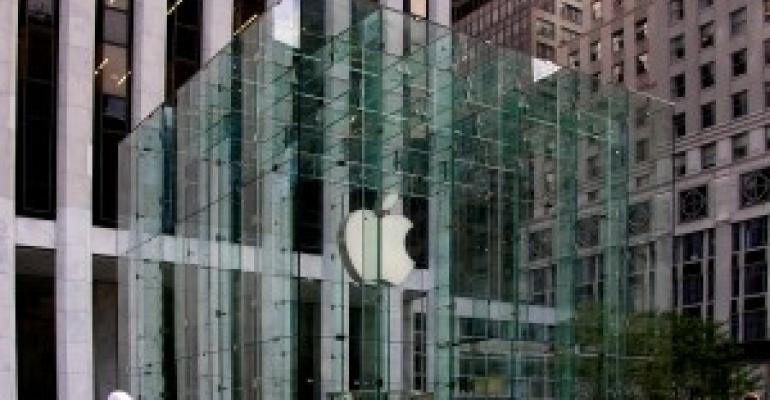 There is a lot of buzz on the web this week about the possibility of Apple being seen as an anchor for malls and lifestyle centers as opposed to as an inline tenant.
The Wall Street Journal was the first to raise the issue, noting that Apple
brings in revenues and shopper traffic that are actually more robust than those of traditional department store anchors, like Macy's or Sears.
There is a lot of buzz on the web this week about the possibility of Apple being seen as an anchor for malls and lifestyle centers as opposed to as an inline tenant.
The Wall Street Journal was the first to raise the issue, noting that Apple
brings in revenues and shopper traffic that are actually more robust than those of traditional department store anchors, like Macy's or Sears.
The Journal notes:
In Apple's fiscal year through September, it had sales of $34.1 million per retail store. Macy's much larger stores generated $29 million on average in sales last year, and J.C. Penney, just $16.1 million, estimates Michael Exstein of Credit Suisse.
The story's premise hinges on two pieces of data—both of which seem to come straight from Apple. The story is pitched as if the Journal has dug around and discovered Apple's secret sauce. But it almost reads as if Apple may have planted the idea itself, as a way of getting the discussion going.
Here's the key paragraph:
More people now visit Apple's 326 stores in a single quarter than the 60 million who visited Walt Disney Co.'s four biggest theme parks last year, according to data from Apple and the Themed Entertainment Association. Apple's annual retail sales per square foot have soared to $4,406—excluding online sales, according to investment bank Needham & Co. Add in online sales, which include iTunes, and the number jumps to $5,914. That's far higher than the sales per square foot and online sales of jeweler Tiffany & Co. ($3,070), luxury retailer Coach Inc. ($1,776), and electronics retailer Best Buy Co. ($880), according to estimates.
That figure jibes with some talk at last week's NAREIT convention. Specifically, according to Edward Glickman, president and CEO of regional mall REIT PREIT, Apple's sales per square foot tend to be 30 times higher than those of its competitors.
Meanwhile, according to comments made by Glimcher Realty Trust Chairman & CEO Michael Glimcher during last week's NAREIT conference, adding an Apple store to Glimcher's Polaris Center property in Columbus, Ohio will boost the overall mall's sales-per-square-foot average by $50.
Of course, the importance of that figure is that a mall's average sales-per-square-foot is one of the factors that determines how much rent a landlord can charge. So adding an Apple store can be a huge coup in terms of eventually driving rents upwards.
To put the $4,406 sales-per-square-foot figure into additional perspective, the sales per square foot average at regional malls peaked in 2007, when the monthly average was $415.71 per square foot, according to ICSC. Last year the figure was $386.43 per square foot and through March of this yearthe number is $400 per square foot.
Drilling down a bit, sales at entertainment and electronics retailers average $1,275 per square foot as a group. Clearly Apple is driving that number. And it's also clear that Apple vastly outperforms its peers. Overall, Apple's figure is 10 times the average for most mall tenants and about four times the average for all entertainment and electronics retailers.
Lastly, nobody can argue that the brand does an excellent job of running its stores, complete with first rate customer service and marketing buzz surrounding new product launches.
So you look at all that, and the case that Apple should be treated as an anchor seems pretty compelling. Yet as the blog Passions of a Zealot points out, as an inline tenant Apple pays many times the amount of rent that a department store would. Some people question whether the brand shouldn't be elevated to anchor status because of the traffic it draws, complete with more favorable rental rates.
But there are other points to consider.
Mall anchors don't just serve as a point of attraction for customers. By signing extra long-term leases for huge amounts of space they help property owners secure financing from lenders, according to this story from CNBC. Plus, department stores spend a lot of money on marketing and advertising out of their own pocket, which helps bring more shoppers to the mall.
Traditional anchors such as Macy's [M 27.00 -0.29 (-1.06%) ] and J.C. Penney [JCP 34.11 -0.01 (-0.03%) ] do a large amount of local advertising, which helps to publicize the mall for its operators. They also sponsor community events."When is the last time you saw Apple do that?" asked Craig Johnson, president of Customer Growth Partners.
Regardless of whether Apple can successfully convince its landlords that it should be viewed as an anchor in its own right, the brand is certainly seen as a trailblazer by the retail community.
Earlier this week, department store chain JC Penney announced it was hiring Ron Johnson, Apple's head of retail stores, as its chief executive. JC Penney likely hopes Johnson will help the chain grow its online business, while at the same time drawing customers to its brick-and-mortar stores, according to The New York Times.
Johnson may have his work cut out for him, however, given how different JC Penney's position in the market is from that of Apple:
“Apple sells best-in-class product and faces basically little to no competition,” said Michelle Clark, an analyst with Morgan Stanley. “J. C. Penney, on the other hand, operates in an intensely competitive industry and sells merchandise that is undifferentiated versus peers and in fact has been lagging peers.”

